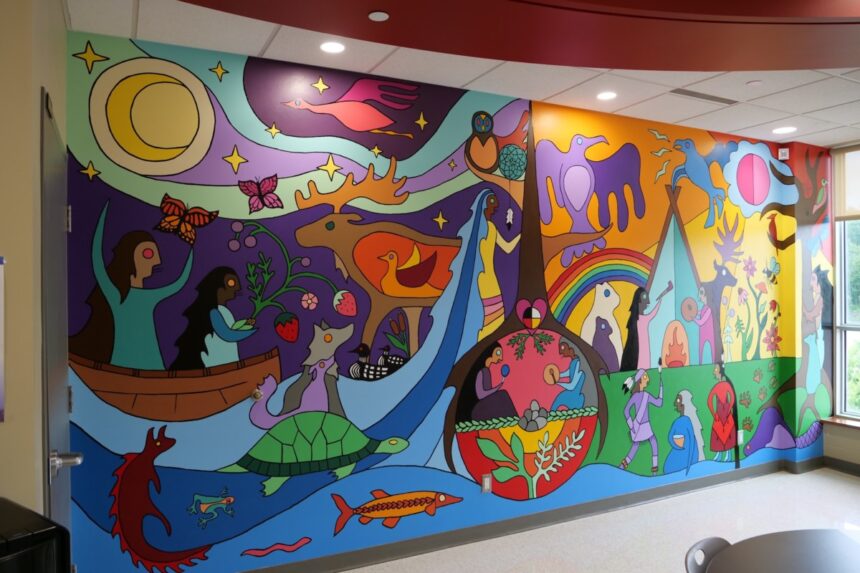A vibrant new mural now adorns the walls of St. Mary’s College in Sault Ste. Marie, transforming the school’s Indigenous culture room into a space of learning, healing, and celebration of Anishinaabe heritage.
The striking artwork, created by Indigenous artist Isaac Weber, depicts the Seven Grandfather Teachings that form the moral foundation of Anishinaabe cultural values: wisdom, love, respect, bravery, honesty, humility, and truth.
“This mural isn’t just decoration – it’s a living teaching tool,” explains Weber, who spent several weeks completing the project. “Every symbol connects students to teachings that have guided our people for generations.”
The project emerged from collaboration between the school’s Indigenous education team and the Huron-Superior Catholic District School Board, which sought to create a more culturally responsive environment for Indigenous and non-Indigenous students alike.
Principal John Caputo notes the immediate impact on the school community. “You can feel the difference when students enter this space now. There’s a sense of pride, especially among our Indigenous learners who see their culture honored in such a prominent way.”
The mural incorporates traditional Woodland style painting with contemporary elements, featuring animals representing each teaching alongside sacred medicines like sweetgrass, sage, cedar, and tobacco. Weber carefully selected a color palette that honors traditional earth tones while incorporating vibrant blues and greens reflecting the natural landscape of Northern Ontario.
For Grade 11 student Melissa Neshkiwe, the artwork provides a sense of belonging. “Seeing our teachings on display makes me feel seen. It’s like having a piece of my grandmother’s kitchen right here at school,” she says, referring to similar imagery she grew up with in her family home.
The project also serves as a response to the Truth and Reconciliation Commission’s Calls to Action, specifically those addressing education. Indigenous Education Lead Sarah McLeod explains, “This visual representation of Anishinaabe knowledge systems helps all students understand Indigenous perspectives in ways textbooks simply cannot.”
Community Elder Joseph Sayers blessed the completed mural in a small ceremony attended by students, staff, and local Indigenous leaders. “Art speaks when words sometimes fail,” Sayers remarked during the gathering. “These walls now tell stories that will educate generations of young people about our ways of being.”
The mural has already become a gathering place for cultural programming, including talking circles and traditional teachings. Students from across the school visit during lunch periods and breaks, often bringing non-Indigenous friends to explain the significance of various elements.
Weber, who has created similar installations across Northern Ontario, sees the project as part of a larger movement of Indigenous cultural reclamation. “Our ancestors couldn’t practice these traditions openly. Now they’re celebrated in institutions where our language and culture were once forbidden. That’s powerful medicine.”
School board officials hope the project will inspire similar initiatives throughout the district. Superintendent Maria Esposito points to research showing improved educational outcomes when Indigenous students see their cultures reflected in their learning environments. “This isn’t just about aesthetics – it’s about creating spaces where all students can thrive.”
For the wider Sault Ste. Marie community, the mural represents another step in the ongoing journey of reconciliation. Located in Robinson-Huron Treaty territory, the city has been working to acknowledge its Indigenous heritage and strengthen relationships with neighboring First Nations.
As students filter in and out of the culture room, many pause to study different aspects of the artwork. “I learn something new every time I look at it,” says Grade 9 student Thomas Wilson. “Yesterday our Elder explained the significance of the turtle. Tomorrow maybe I’ll understand more about another teaching.”
The mural stands as a colorful testament to the enduring strength of Indigenous knowledge and its growing place in mainstream education – bringing beauty, cultural understanding, and healing to the heart of a northern Ontario school.






